10 Anti-war shocking artworks
In the 20th century, art was one of the most important players in confronting social, cultural, and political issues. Developments in image technology and accessibility have reached all corners of the world and all classes. Photography, movies, posters, performances, and installations are just a few examples of activities that brought to the forefront protest art, transforming their creators from artists into activists that shaped the future.
Art history made obvious the fact that starting with the French Revolution, paintings can inspire and mobilize the masses. However, given the historical context, the artworks bore many symbolic motifs, embodied ideals, and did not focus so much on pain or cruel aspects. In contrast to this, DADA, the first declared anti-war art movement, approached the subjects of war, death, terror, insanity, diseases, domination, and conquest at a completely different level. The artists were often on the frontline, thus, by interiorizing the traumatic experiences there, they were able to exteriorize them on their canvas later. The results speak for themselves. Tzara, Picabia, Max Ernst, Otto Dix are some of the representative and active names inside the DADA movement.
GET MORE FROM LEVEL

WWI and WWII have awakened a civic and pacifist consciousness across the globe. People gathered around in meetings and protested against crime, war, loss, and physical mutilation. Artists became a key element in the representations of one community’s beliefs. The 20th century has offered the world some of the most extraordinary art creations that militate for peace and universal morality. Their wish is to make the world a better and safer place, for us and future generations. Famous artists questioned and confronted political authorities in their struggle to raise awareness about the consequences of war in the short and long term.
The short presentation below redefines the role of art through the eyes of iconic artists and emblematic artworks.
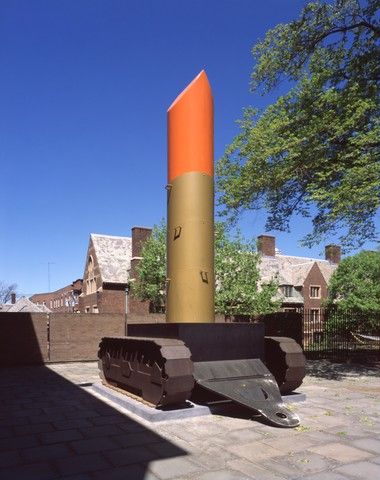
Claes Oldenburg, Lipstick (Ascending) on Caterpillar Tracks (1969–74)
A monumental artwork consisting of a tube in the shape of a lipstick expanding from a military vehicle. Deeply critical, the sculpture created by Claes Oldenburg is a form of protest against the Vietnam war. This 24-foot-high artwork is regarded both as an artistic joke and an anti-war creation.
Very popular, Oldenburg’s Lipstick (Ascending) on Caterpillar Tracks was installed on the campus of Yale University. Students and other sympathizers used this artwork as a backstage for ulterior protests.

ASCO, First Supper (1974)
First Supper (After a Major Riot) is a performance act made on Christmas Eve, by the collective ASCO. They are having a meal during rush hour in East L.A, on Whittier Boulevard, in a rather strange way, with their face painted and surrounded by dolls. The performance is inspired by the Chicano Moratorium Committee Against The Vietnam War, the largest anti-war action taken by any single ethnic group in the USA.
The group organized an anti-Vietnam rally in 1970 on Whittier Boulevard. Unfortunately, the demonstrations were brutally broken by the police, with 4 deaths, stores on fire, and more than 150 people arrested.

Chris Burden, Shoot (1971)
Shoot is a stupefying piece that is finalized with the artist, Chris Burden, being wounded by a .22 rifle. Burden asked a friend to shoot him in front of a live audience. The friend intended to aim for Burden’s arm side but instead, the bullet went right through the arm.
The purpose of the act was that the audience would experience a person being shot in front of them and not in a detached setting, in front of a TV. Burden wished to re-sensitive people to the violence. His work questioned concepts of power, obedience, boundaries, and responsibility for human fellows.

Carl Fredrik Reuterswärd, The Knotted Gun a.k.a. Non-Violence (1980)
The Swedish artist Reuterswärd was a close friend of John Lennon, a musician who promoted peace in the world. In 1980, a tragic event shocked the audiences, Lennon was assassinated by a fan. The artwork The Knotted Gun is often seen as a tribute to the singer’s vision of peace on Earth.
Reuterswärd’s sculpture is nowadays worldwide replicated in over 30 duplicates, with a famous bronze version unveiled in 1988 in front of the United Nations’ headquarters. It is the perfect example of an artwork powerful enough to become an international symbol of peace.
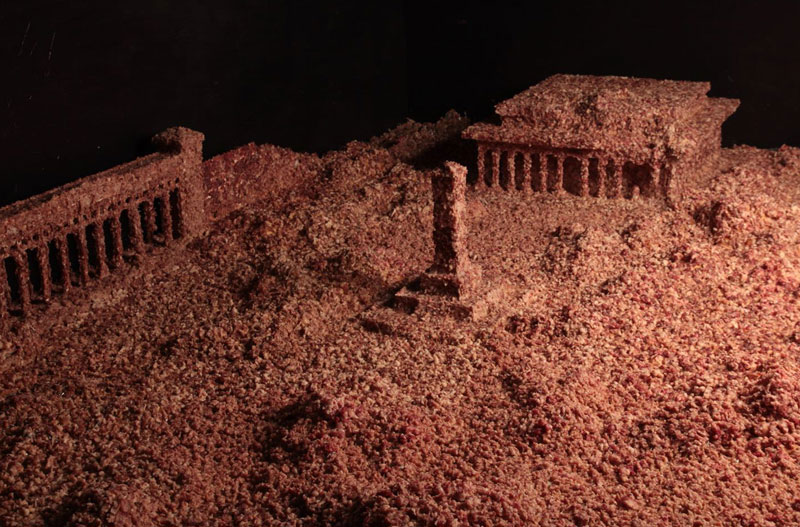
Guo Jian, Tiananmen Square (2014)
A diorama of the famous Chinese Tiananmen Square was designed in a raw outline by Guo Jian. The artwork surprises a model of the square after the massacre in 1989, a nightmare in which the artist participated physically. He chose to cover the entire artwork with 160 kilograms of pink, uncooked meat, obtaining a terrifying – gross image.
The Tiananmen Square installation was highly provocative and quickly became a motif for the Chinese authorities to arrest the artist. Even if the installation never left the artist’s studio, it is a monument dedicated to the people who fought for freedom in 1989 and criticized the authorities’ political decisions.
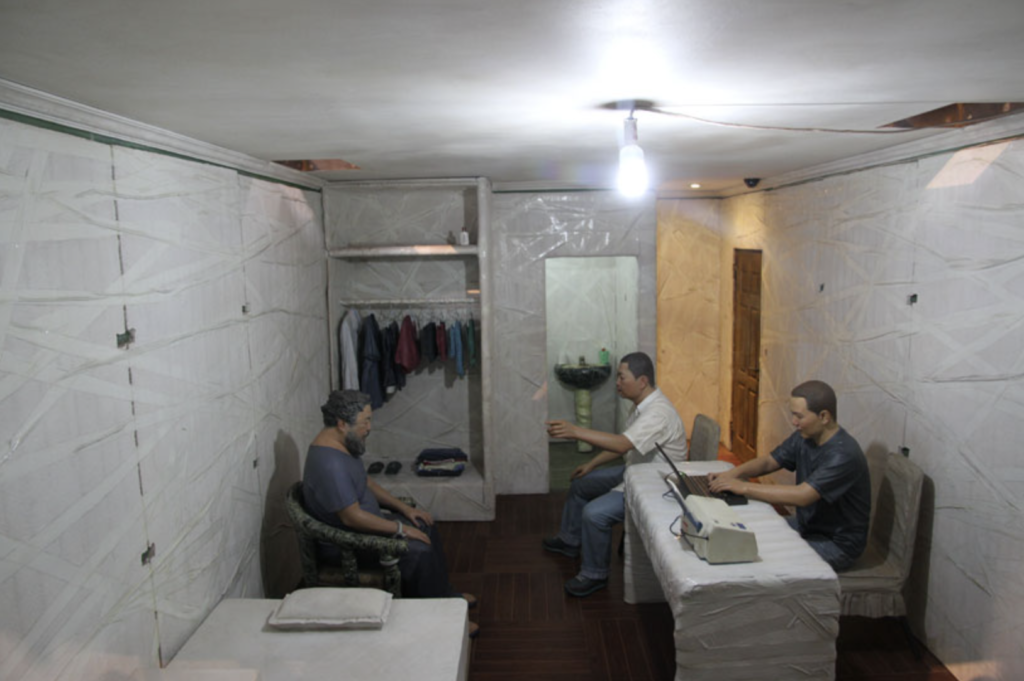
Ai Wei Wei, S.A.C.R.E.D. (2013)
Ai Wei Wei is another Chinese artist with worldwide recognition for this powerful social and political layered art. He was also imprisoned for his artworks that criticize the Chinese political system.
S.A.C.R.E.D. consists of a series of dioramas that present model figures of himself and the prison guards while he was incarcerated. The installation is split into six parts to represent the rooms and the actions the artist was subjugated to by the authorities.
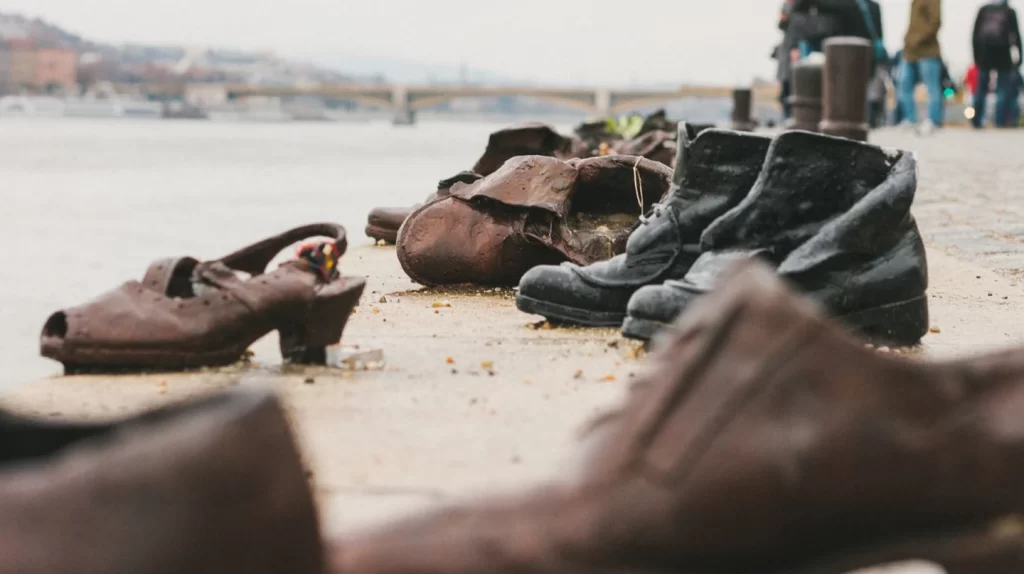
Gyula Pauer, Shoes on the Danube Bank (2005)
Several women’s shoes, men and children’s shoes are displayed on the banks of the Danube River in Budapest, Hungary. Scattered in different positions, the shoes look like their owners just stepped out of them.
The artwork is a memorial dedicated to the Hungarian Jews that died during WWII. Thousands of Jews were shot between 1944-1945, leaving their bodies to be carried away by the river. The shoes imagined by Pauer seem so real that visitors can even imagine the people wearing them. Deeply touching and highly effective, this installation triggers a sense of shock and sadness.
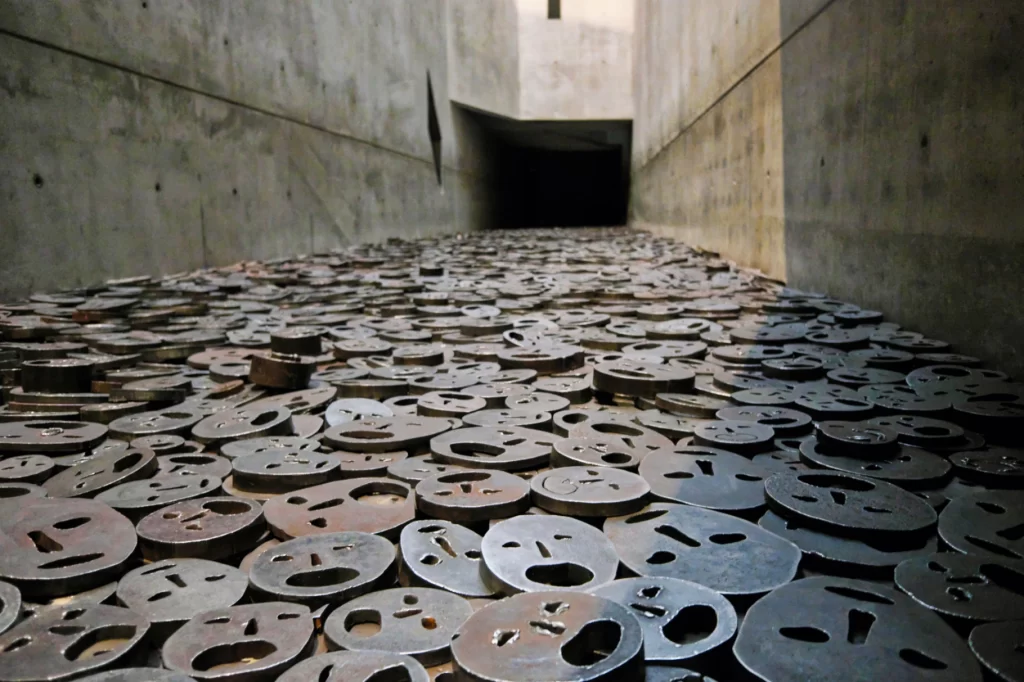
Menashe Kadishman, Shalekhet (Fallen Leaves) 2001
A poignant installation exhibited in the Jewish Museum Berlin, made by an Israeli contemporary artist, Menashe Kadishman, suggests the absence of Jews from German society. An entire room is filled with over 10.000 faces made of iron with their mouths opened.
The plates seem to embody the agony and the anonymity of those who fall, reducing them to a simple number. The viewer can easily be immersed and feel guilty. Walk on them if you can. The work can extend to all types of war and horrors, not just the Holocaust, and is intended to force us to reevaluate the world, the values, and the principles we live after.
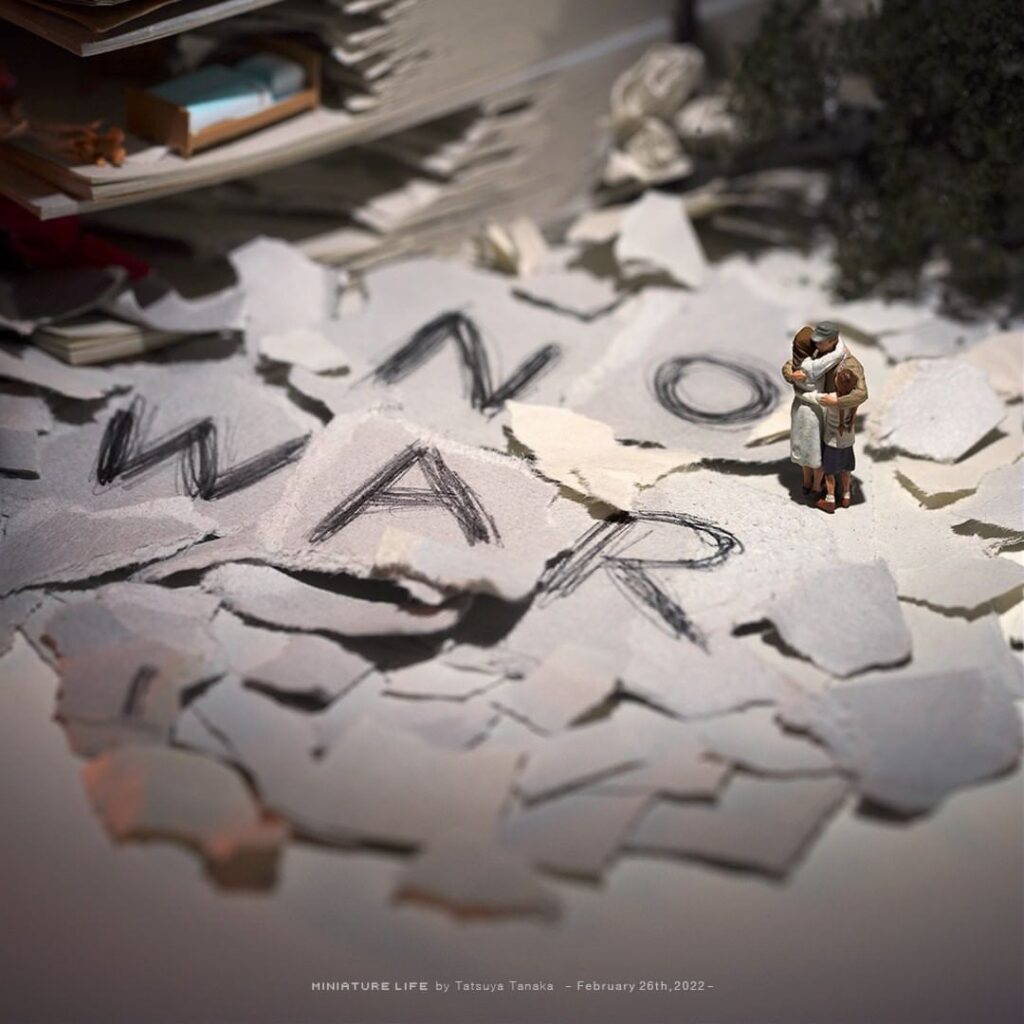
Tatsuya Tanaka, NO WAR (2022)
The recent war in Ukraine urged artists to create art about it. The installation NO WAR is a miniature work of art featuring a building made of stacked papers pierced by a pencil, the equivalent of a missile. The landscape is devastating, everything is destroyed by the blast. Below the stacks, there is a “NO WAR” message scribbled on a piece of paper. Next to it, a soldier says goodbye to his family and hugs them for the last time.
Deeply sensitive, the work embodies devastation on several levels. Environmental, physical, and emotional. This piece shows the effect of war upon all of us and urges us to take action.
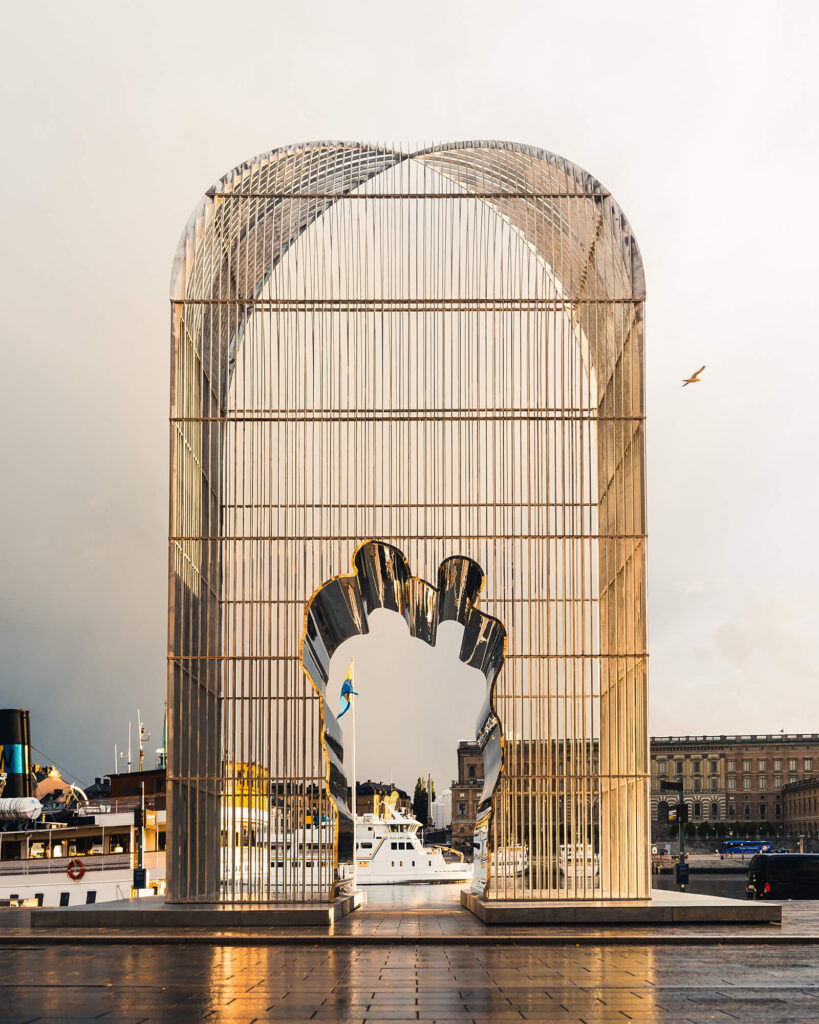
Ai Wei WEI, Arch (2022)
Another mind-blowing creation from Ai Wei Wei was installed in Stockholm outside the Nationalmuseum. A huge cage-like steel arch with two intertwined human beings that breach through the hard stone metal. The artwork suggests physical barriers that are broken by the people obtaining free passage.
The work is a multilayered symbol of refugee stories, freedom, and anti-racism and speaks about isolation and vulnerability (given the pandemics), or the war in Ukraine. Wei Wei is reminding us of the fragile stability we are all responsible to keep.
Can Art Make Us More Socially Active?
Political propaganda has always used art to influence and form opinions. History does not forget Marinetti’s manifesto from 1909 that glorified war, a movement that ironically died during WWI when atrocity became habitual.
Artistic representations of war can affect us and in the long term can be an effective tool for influencing a conflict, since the artists are still being imprisoned for their creations. Only recently, the female artist Alexandra Skochilenko was imprisoned by Russian authorities. She replaced price labels in supermarkets with anti-war messages against Russia’s invasion of Ukraine.
Art will not let us forget the horrors of war and loss, the agony and conflicts in Ukraine, Afghanistan, Yemen, Syria and so many others. Is art decisive? No. Can art raise social consciousness? Yes.
Anton Chekhov said, “The role of the artist is to ask questions, not answer them.” By asking questions, artists implicitly create ground for social debates, conversations, and learning. Artists through their work can change the world and eventually, shape the future.

Leave a Reply